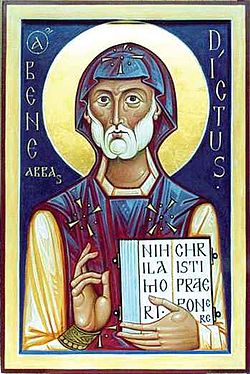Top Qs
Timeline
Chat
Perspective
March 14 (Eastern Orthodox liturgics)
From Wikipedia, the free encyclopedia
Remove ads
March 13 - Eastern Orthodox liturgical calendar - March 15

All fixed commemorations below are observed on March 27 by Orthodox Churches on the Old Calendar.[note 1]
For March 14th, Orthodox Churches on the Old Calendar commemorate the Saints listed on March 1.
Saints
- Martyrs Basil and Euphrasius, together with other Christians, in Thessaloniki.[1]
- Martyr Florentius, in Thessaloniki, by fire.[2] (see also: October 13)
- Martyr Alexander, in Thessaloniki (c. 285-305).[3][note 2]
- Martyr Eustathius and his company, at Carrhae, Mesopotamia (741)[4][5][note 3]
- Venerable Euschemon the Confessor, Bishop of Lampsacus (9th century)[4][7][8][note 4]
Pre-Schism Western saints
- Holy 47 Martyrs of Rome, baptised by the Apostle Peter, and suffered in Rome under Nero, all on the same day (c. 67)[6][9][10]
- Hieromartyr Leo, Bishop and Martyr, perhaps under the Arians, in the Agro Verano in Italy.[6][9]
- Martyrs Peter and Aphrodisius, who obtained the crown of martyrdom in the persecution of the Vandals (5th century)[6][9][11][12]
- Monk-Martyrs of Valeria, in the province of Valeria, Italy, slain by the Lombards (5th century)[9][note 5]
- Venerable Benedict of Nursia, Abbot (543)[4][9][13][14] (see also: July 11 - Translation)
- Saint Diaconus, a deacon in the Marsi in central Italy, martyred together with two monks by the Lombards (6th century)[9]
- Saint Boniface Curetán, a Scoto-Pictish Bishop of Ross (c. 630 or 660)[9][15][note 6]
- Saint Talmach, a disciple of St Barr at Lough Erc in Ireland, and founder of a monastery (7th century)[9][16]
- Saint Matilda (Mathildis, Maud), wife of German king Henry the Fowler, who founded, among others, the monasteries of Nordhausen, Pöhlde, Engern and Quedlinburg in Germany (968)[9][17]
Remove ads
Post-Schism Orthodox saints
- Saint Rostislav-Michael, Great Prince of Kiev (1167)[4][18][19]
- Saint Theognostus of Kiev, the Greek Metropolitan of Kiev and all Rus' (1353)[4][20][21][note 7]
- Venerable Andreas (Andrew), Abbot, of the Holy Trinity Monastery in Rafailovo, Siberia (1820)[22][note 8]
Other commemorations
Icon gallery
- St. Benedict of Nursia.
- Saint Matilda.
- Metropolitans of Kiev and all Rus': Photius, Theognostus (center), and Cyprian.
- Theotokos of St. Theodore, original icon from Epiphany Monastery in Kostroma.
Notes
- The notation Old Style or (OS) is sometimes used to indicate a date in the Julian Calendar (which is used by churches on the "Old Calendar").
The notation New Style or (NS), indicates a date in the Revised Julian calendar (which is used by churches on the "New Calendar"). - He suffered for the holy icons under the iconoclast emperor Theophilus (829-842), and having been imprisoned, he was sent into exile and died.
- Bishop of Ross, very likely a Roman by birth, he enlightened the Picts and Scots. He is said to have founded a great many churches.
- It was through his influence that the Grand Prince Simeon sent money to the Byzantine Emperor John Cantacuzene for repairs to the Great Church of Hagia Sophia.
- The Venerable Saint Andrew was born in 1746 in Russia. He became an ascetic at the Holy Trinity Monastery of Rafailovo, Tyumen, near the Diocese of Tobolsk, where he also served as the Igumen (Abbot). Later he continued his life at the Monastery of St Symeon in Moscow. The Venerable Andrew reposed in peace in the year 1820.[22]
- This was the cell icon of St Alexander Nevsky.[26] The year 2013 marks the 400th anniversary of the glorification of the Theodore Icon of the Mother of God, for the election to the throne of Mikhail Fedorovich Romanov (Michael I of Russia).[25]
Remove ads
References
Sources
Wikiwand - on
Seamless Wikipedia browsing. On steroids.
Remove ads




